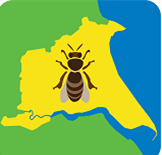Planting for bees
5 Tips to create a bee friendly garden
1. Rethink Your Lawn
Do you need so much grass to mow? You could replace part or all of your grass with flowering plants, which provides food and habitat for honey bees, bumble bees, solitary bees, butterflies and other pollinators.
Bees love much of what we often think of as weeds. Dandelions, clover, rosebay willow herb and ivy, for example, provide nectar and pollen at important times for our bees. Consider leaving a patch for such weeds and when you see dandelions in flower you could wait until those flowers begin to turn before pulling them up.
2. Select simple single flowers
Double flowers don’t offer much to our bees. Double flowers look showy but produce much less nectar and make it much more difficult for bees to access pollen. Instead look for simple single flowers like single dahlias, alliums, buddleia, foxgloves, penstemons, snapdragons.
One absolute favourite of bees and great ground cover is the Poached Egg Plant (Limnanthes douglasii)

3. Skip the highly hybridized plants
These have been bred not to seed and thus produce very little pollen for bees.
4. Plan for blooms year-round
Plant at least three different types of flowers in your bee garden to ensure blooms through as many seasons as possible. This will provide bees and other pollinators with a constant source of food. For example:
- crocus, hyacinth, borage, calendula, and wild lilac provide enticing spring blooms in a bee garden.
- bees feast on cosmos, echinacea, snapdragons, foxglove, and hosta in the summer.
- for autumn, sedum, asters, witch hazel are late bloomers that will tempt foragers.
5. Build a Bee Bath
Bees need a place to get fresh, clean water. Fill a shallow container of water with pebbles or twigs for the bees to land on while drinking. Make sure to maintain the container full of fresh water to ensure that they know they can return to the same spot every day in your bee garden.

